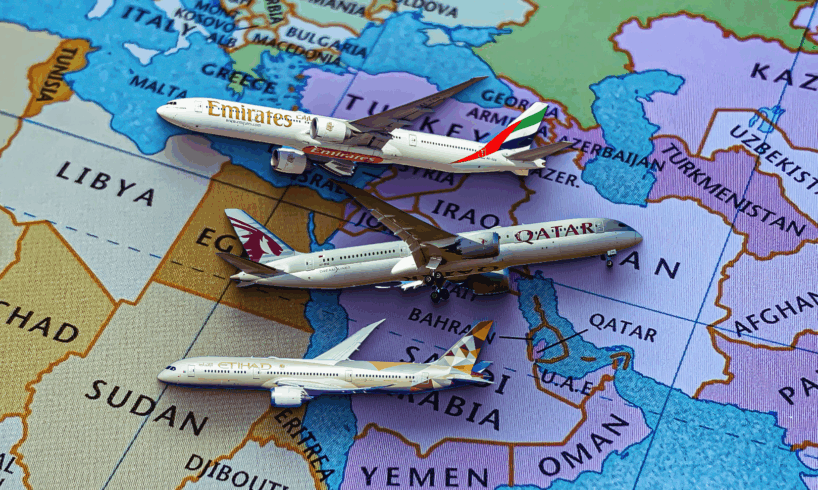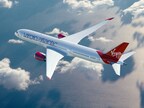
Is everything bigger in America? While that may be true of many things, it is certainly not true of commercial passenger jets. The US is not even home to the world’s largest extant military transport aircraft. The An-124 Ruslan (operated by Ukraine and Russia) is bigger than the C-5M Super Galaxy. When it comes to widebody commercial passenger jets, two small Middle Eastern countries not only operate a similar number of widebody aircraft, but they also operate larger widebodies.
Emirates
IATA/ICAO Code
EK/UAE
Year Founded
1985
CEO
Ahmed bin Saeed Al Maktoum
Expand
The small Gulf State of Qatar is home to Qatar Airways
, while the United Arab Emirates (the UAE) has two flag carriers, Emirates
and Etihad Airways
. In the United States, four carriers operate widebody passenger jets: Delta, American, United, and Hawaiian. Here is a comparison of passenger widebody fleet sizes between the United States and Qatar & the UAE.
Two Small Gulf States
Photo: IanC66 | Shutterstock
Qatar is a small Gulf State home to around 2.6 million inhabitants, most of whom are migrant workers. The country’s citizen population is only around 380,000, which is fewer than the least populated US state. It also only covers an area of around 4,500 square miles, placing it between Delaware and Connecticut in size.
The United Arab Emirates is home to around 11 million people. Like Qatar, most of the people living in the UAE are migrant workers, with Emirati citizens only making up to 15% of the population, or a little more than 1 million. Measuring the country by land area, the UAE covers around 32,000 square miles, making it the same size as South Carolina.
Despite these countries’ small size, they are home to around the same number of passenger widebody aircraft as the United States, and they possess larger aircraft. These airlines have purchased the largest commercial aircraft on the market for years, while carriers in the US abandoned ordering the largest passenger jets decades ago.
Number Of Qatari & Emirati Widebody Aircraft
Photo: Vincenzo Pace | Simple Flying
Between Qatar and the UAE, these two countries operate 521 widebody aircraft. Qatar Airways is the flag carrier of the State of Qatar and is based at Doha Airport (officially Hamad International Airport). It has a fleet of 227 mainline aircraft, most of which are widebody aircraft. It has 10 Airbus A330s, 58 Airbus A350s, eight Airbus A380s, 64 Boeing 777s, and 51 Boeing 787s in inventory. That gives it a fleet of 191 widebody aircraft.
The largest airline in the UAE is Emirates, which boasts over half of the world’s A380 Superjumbos. Emirates boasts the largest widebody fleet of any airline in the world and operates a fleet made up exclusively of widebody aircraft (apart from a single A319). Until late 2024, Emirates exclusively operated A380s and Boeing 777s. Now its fleet is composed of 116 Airbus A380s, four Airbus A350s, and 140 Boeing 777s, giving it a widebody fleet size of 260 aircraft.
Qatar & UAE widebody fleets:
Qatar Airways:
191 widebodies
Emirates:
260 widebodies
Etihad:
70 widebodies
Total:
521 widebodies
The second flag carrier of the United Arab Emirates is Etihad, which operates a fleet of 100 commercial aircraft. These include 70 widebody aircraft made up of seven Airbus A380s, six A350s, 14 Boeing 777s, and 43 Boeing 787s. The low-cost carrier, flydubai is also based in the UAE. It operates an all-Boeing 737 fleet of 89 aircraft. It has placed an order for 30 Boeing 787s, but they haven’t arrived yet. Other low-cost UAE carriers like Air Arabia also currently operate only narrowbody fleets.
Related
Emirates’ Massive Fleet Commitment: All The Aircraft Still To Be Delivered
Emirates is going through a period of huge upheaval and modernization in its fleet with over 300 aircraft on order.
Number Of US Widebody Aircraft
Photo: Santi Rodriguez | Shutterstock
Only four passenger airlines based in the US operate widebody aircraft: Delta Air Lines
, United Airlines
, American Airlines
, and Hawaiian Airlines
. Cargo carriers like UPS and DHL also operate widebody aircraft, but those are excluded for the purposes of this article. Qatar Airways Cargo is also excluded. American Airlines operates 67 Boeing 777s and 59 Boeing 787s for a total of 126 widebody aircraft.
Overall, Delta operates an exceptionally diverse fleet, although it is transitioning to an all-Airbus widebody fleet. Delta operates 75 Airbus A330s, 36 Airbus A350s, and 60 Boeing 767s. The Boeing 767s are expected to be replaced by Airbus aircraft eventually. In all, Delta has a fleet of 171 widebody aircraft. Hawaiian has ordered a fleet of 12 Boeing 787s, although these will be inherited by Alaska Airlines as it acquires the airline. Currently, Hawaiian has three 787s in service.
US passenger airlines’ widebody fleets:
American Airlines:
126 aircraft
Delta Air Lines:
171 aircraft
Hawaiian Airlines:
3 aircraft
United Airlines:
226 aircraft
Total:
526 aircraft
United operates the largest widebody fleet in the United States and one of the largest in the world, although it’s still smaller than Emirates. United has an all-Boeing fleet that includes 53 Boeing 767s, 96 Boeing 777s, and 77 Boeing 787s, giving it a total widebody fleet of 226 aircraft. This means the four airlines have a total of 526 widebody aircraft in service, only five more than Qatar and the UAE.
Boeing 777X Too Big For US?
Photo: Tom Boon | Simple Flying
The delayed Boeing 777X is expected to enter service in 2026. It will become the largest commercial passenger jet in production and has secured a total of 521 firm orders from airlines and lessors around the world. However, most of these orders are from the Middle East, while none are from the United States.
Incredibly, of the 521 orders, 205 are from Emirates, 94 are from Qatar Airways, and 25 are from Etihad. This includes freighter variants of the aircraft. That means 324, or 62%, of the aircraft’s current firm orders are from these two small Gulf States. The large aircraft is seen as a good fit for the Middle East, where these airlines operate long-haul flights to a single major hub.
The Boeing 777X might otherwise be considered as too big for US airlines. Pan Am may have led the world in the era of giants, being the first to operate the Boeing 747 in 1969, but the US airlines have been effectively downsizing their high-end widebody aircraft for years. They have retired the 747s, declined to purchase the A380, and show no interest in the 777X. Instead, the A350-1000 and Boeing 787-10 are emerging as the largest widebody aircraft in the United States and are seen as better fits for US airlines’ models of operating around half a dozen hubs dispersed across the country.
Related
How The US Trade War Could Affect The Boeing 777X Program
The Boeing 777X is particularly vulnerable to a trade war as all its orders are to export customers.
Middle East Has Bigger Widebodies
Photo: Bradley Caslin | Shutterstock
It’s not that the UAE and Qatar have about the same number of passenger widebody aircraft as the United States, but it’s also that these aircraft are generally bigger. American retired its 747s in 1994, and Delta and United retired theirs in 2017. Meanwhile, the UAE and Qatar boast over half of the world’s remaining Airbus A380 Superjumbos. Together, these airlines possess 131 A380s, according to Planespotters.net.
While US carriers have 163 Boeing 777s, these are aging and gradually being retired and are not being replaced by 777X aircraft. Instead, the largest aircraft that US carriers are ordering are the 787 and A350. Meanwhile, Qatar and the UAE have 218 Boeing 777s currently in service and have another 324 on firm order.
Widebody type:
Qatar & UAE (passenger airlines):
United States (passenger airlines)
Boeing 767:
113
Airbus A330:
10
75
Boeing 787:
94
139
Airbus A350:
68
36
Boeing 777:
218 (324 on order)
163 (0 on order)
Airbus A380:
131
US carriers also have 113 aging Boeing 767s and 75 Airbus A330s in service. These Middle Eastern carriers don’t have any Boeing 767s in service and have only 10 Airbus A330s. The 767 and A330 are smaller widebody types compared with the A350, 787, and 777.
Even More Widebodies In The Middle East
Photo: Vincenzo Pace | Simple Flying
If one were to expand to include all of the Gulf States, then there are far more widebody aircraft in the Gulf than in the US. Saudi Arabian Airlines has 37 Airbus A330s, four Boeing 747s (cargo), 43 Boeing 777s, and 21 Dreamliners for 105 widebody aircraft. Bahrain’s Gulf Air has 10 Boeing 787s, Oman’s Oman Air has eight Boeing 787s, and Kuwait’s Kuwait Airlines has five Airbus A330 and 10 Boeing 777s. That’s another 138 widebody aircraft, giving the Gulf States a total of 659 widebody aircraft to the US’s 526.
The presence of so many widebody aircraft in the Middle East is partly due to geography. The Gulf States function as a global point of connection between Europe, the Asia-Pacific, Africa, and even the Americas. Meanwhile, US-based airlines are primarily concerned with short-haul domestic flights within the United States and to the US near-abroad in Canada, Mexico, Central America, and the Caribbean. Narrowbody aircraft generally have the range needed to serve these destinations.
The top four US airlines (United, Delta, American, and Southwest) have the four largest fleets in the world, although they are overwhelmingly narrowbody aircraft (and only narrowbody aircraft for Southwest). Together, these four giants possess almost 4,000 mainline aircraft besides the thousands more operated by their regional airlines and contractor airlines like SkyWest. Finally, it should be emphasized that the United States remains, by a considerable margin, the largest airline market in the world.
Related
How China’s Response To Trump’s Tariffs Could Hurt Boeing
China’s reciprocal tariffs could price Boeing aircraft out of the second-largest aviation market if they stick.





